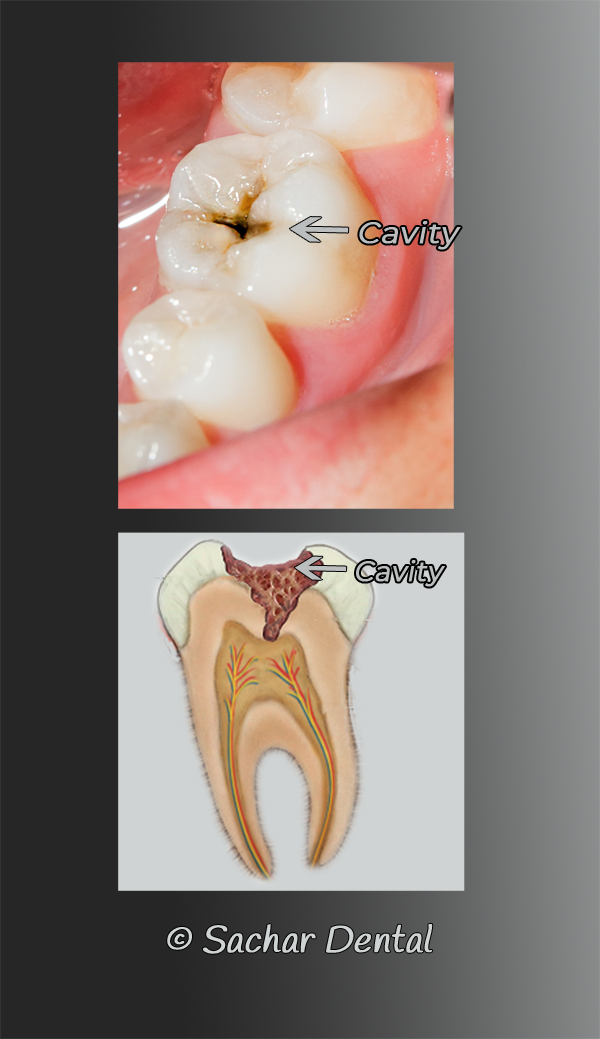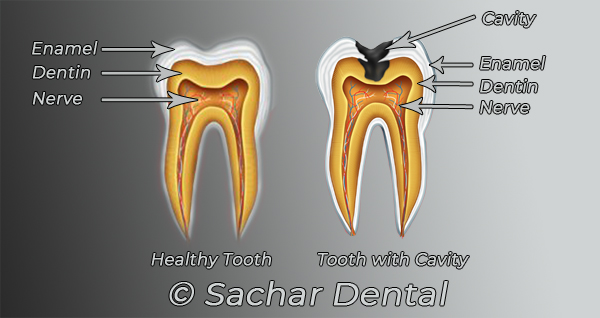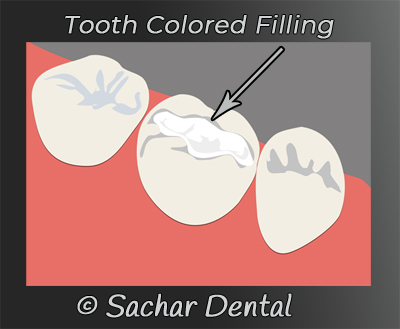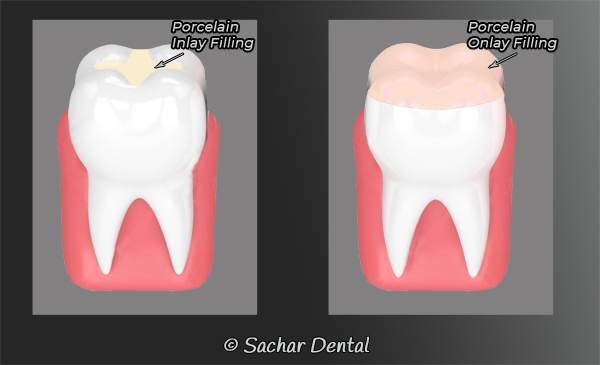Sachar Dental NYC
For SAME day / emergency appointments
Call (212) 752-1163
All the below content has been written by NYC Dentist, Dr. Sandip Sachar.
Dentist NYC for Cavity Fillings
At Sachar Dental NYC, we specialize in General Dentistry and cavity fillings. Dental fillings are used to fill cavities that can form in the teeth. At Sachar Dental NYC, we use only the most advanced dental materials available today, for our dental cavity fillings. These materials enable us to fill dental cavities with the longest lasting, strongest and most durable results that are the most cosmetically appealing. The use of top-of-the-line composite tooth colored fillings and porcelains, at Sachar Dental NYC, allows us to make a cavity filling virtually undetectable, and achieve long-lasting results, while restoring the function of the teeth.
On this page: (Click topic below)
What is a dental cavity?
A dental cavity is a hole or deficit that can form within a healthy tooth. It is caused by tooth decay. Tooth decay occurs when bacteria break down plaque on, and between the teeth, and under the gums. Plaque forms when food particles are left to remain in the mouth after brushing. Bacteria live off this plaque. A byproduct of bacteria feeding on plaque, is acid that is produced. This acid eats away at the tooth enamel and results in tooth decay and eventually, dental cavities. Dental cavities can appear as a yellowish, black or brown spot or a big hole within a tooth. Dental cavities may cause sensitivity to sweets, hot and cold but can also be asymptomatic.


How can I prevent dental cavities (tooth decay)?
Tooth decay can be prevented, or at least slowed down, with proper oral hygiene and home care. This involves brushing and flossing twice per day for proper removal of plaque from the teeth. However, brushing and flossing alone does not always remove all plaque from teeth. It is also important to have a professional dental teeth cleaning and dental checkup by a dental professional twice per year.
How is a dental cavity filled?
When filling a dental cavity the first step is to remove the decayed or necrotic parts of the tooth. The tooth surface is then thoroughly cleaned or disinfected to remove all bacteria. Once the tooth is cleaned sufficiently, a tooth colored filling material (composite filling) is chemically bonded to fill the tooth. It is filled in the proper shape, size and color. A special light is then used to permanently harden the filling material. A numbing gel and local anesthetic is used in the area to ensure patient comfort prior to starting this procedure.

When dental cavities and deficits within the tooth are too large to simply fill with a tooth colored filling material, a porcelain filling may be necessary, in the form of an inlay or onlay. The technique for both of these is very similar. Any necrotic or decayed part of the tooth is first removed. The remaining surfaces of the tooth are thoroughly cleaned to remove all bacteria. At this stage, a mold is taken to identify the exact shape of the remaining tooth. This mold is sent to our dental laboratory in order to have a porcelain inlay or onlay custom fabricated. A temporary filling is then placed on the tooth to seal it until the permanent porcelain filling is ready. The patient returns on another day, usually a week later, to have the porcelain inlay or onlay filling inserted and permanently bonded to the tooth, after the temporary filling is removed.

When the deficit is even larger, a filling by itself will not work. We will then perform a dental crown procedure. A dental crown covers the entire tooth to give it strength. Similar to the inlay or onlay, once all the necrotic or decayed tooth is removed, and the remaining surfaces are thoroughly cleaned, we take a mold of the tooth. This mold is sent to our dental laboratory in order to fabricate a custom dental porcelain crown. A temporary crown is placed in the interim. The patient then returns at a subsequent visit, usually a week later, to have the temporary filling removed, and the porcelain dental crown permanently bonded to the tooth.
When doing a temporary filling, the first step is to clean the tooth in question. All necrotic or decayed tooth is removed and the tooth is thoroughly cleaned to remove all plaque, bacteria and tartar. The temporary filling starts off as a moldable putty. This putty is placed onto the tooth in question and shaped such that it restores the size, shape and biting surface of the tooth. In a small amount of time this putty hardens forming the temporary filling.
Removal of old silver mercury fillings
At Sachar Dental NYC, our philosophy is always to use the least toxic materials possible for all of our dental procedures. Unfortunately, these new non-toxic materials were not always available in the past. Fillings were often made out of silver amalgam. These fillings were found to contain mercury which can be toxic to the nervous system. Mercury has been linked to many disease processes.

At Sachar Dental NYC, we are very careful and cautious in the removal of old amalgam fillings. It is crucial that the patient does not inhale any vapor that is formed while removing the amalgam filling. It is also crucial to have high-speed and low-speed suction evacuation positioned precisely. They are both positioned precisely over the tooth where the filling is being removed, in order to remove all the vapor and particles that are formed while we are drilling. Our highly training dental assistants at Sachar Dental NYC, hold this high-speed suction firmly in place during the entire procedure. We are meticulous in ensuring there are no particles of the amalgam filling left in the mouth. When necessary, additionally, we use a rubber dam that prevents any of the mercury materials to be left in the mouth. The rubber dam exposes only the tooth being worked on, and protects the rest of the mouth.
How much does a cavity filling cost in NYC?
At Sachar Dental NYC a tooth colored filling costs $300-$450 depending on the severity, size and location of the cavity. Most PPO dental insurances will cover this cost at 80%-90%. If the cavity is too large to be filled with a regular filling, a porcelain inlay or porcelain onlay may be necessary. At Sachar Dental NYC, these will cost $1200-$1500. Most PPO dental insurances cover this cost at 50-80%. For all above charges we will bill the insurance company and collect their portion from them directly. We will only collect the patient’s portion from the patient at the time of the visit. Additionally, we always inform our patients of what to expect as their out-of-pocket costs, before performing any type of procedure. Prior to your visit, we will check with your dental insurance company to determine what are your level of benefits.
Does dental insurance cover the cost of cavity fillings?
Most PPO dental insurances cover the cost of all the types of dental fillings mentioned above at 50-90%. We will submit the claim to your insurance company and collect the insurance portion from the insurance company directly. We will only collect the patient’s portion from the patient at the time of the visit. We always inform our patients ahead of time, of what to expect as their out-of-pocket costs. Prior to your visit, we will check with your insurance company to determine what are your level of benefits.
Can I use flexible spending dollars for cavity fillings?
Yes, you may use your flexible spending dollars to cover charges related to your dental treatment at Sachar Dental NYC. At the time of your service, we will provide you with all the necessary documentation and receipts.
Do you offer payment plans for dental treatment at Sachar Dental NYC?
At Sachar Dental NYC, we offer interest free financing through Lending Club and Care Credit. In 15 minutes, we will let you know if you are approved for interest-free financing. These options will enable you to make payments over the next 12-18 months without any interest charged.
Why are we the best dentists in NYC for cavity fillings?
At Sachar Dental NYC, our philosophy is to always to perform the least invasive dental procedures possible to solve the problem. We try to maintain as much of the natural tooth as possible, and do not rush into more invasive procedures such as extractions or crowns. Additionally, we always use the least toxic dental materials available. Although it costs us more for a BPA-Free filling material, we think it is worth it. We do not pass this cost onto our patients. Our dental filling materials are all mercury-free and BPA-free. And our dental composite and porcelain materials are all top-of-the-line for strength as well as esthetics.
What are the different types of dental fillings?
- Temporary fillings
- Silver or amalgam fillings
- Composite fillings (tooth colored fillings)
- Porcelain fillings (Porcelain inlay and onlay)
- Porcelain crowns
Performing dental fillings is called restorative dentistry. This is because the goal of dental fillings is to restore the original shape, size, and function of the original tooth. Dental fillings are also performed in order to seal the tooth that has a cavity or deficit, in order to stop further decay from bacteria. There are many different types of fillings.
There are temporary dental fillings that are placed on the tooth for a short period of time to seal it and prevent bacteria from spreading inside.
In previous years, dentists used silver metal in the mouth to fill cavities. At Sachar Dental NYC, we believe in using the least toxic materials, and we never use silver amalgam fillings.
We use a resin composite material that is BPA-Free and results in a functional and cosmetically appealing tooth colored filling.
We also use porcelain to fill larger cavities. There are two types of porcelain fillings, inlay and onlay. When we fill the inside of the tooth, it is called an inlay filling, and when we fill the inside and replace one of the outside surfaces of the tooth, it is called an onlay.
When do we use each type of dental filling?
Tooth Colored Fillings: When patients present with small to medium sized dental cavities, we are able to fill them with tooth colored fillings called composite fillings. The composite filling is able to seal the tooth and restore the shape, appearance and function of the tooth. In order to achieve a more cosmetic result, we always match the color of the composite filling material to the color of the patient’s tooth. This produces a dental filling that is durable, functional and cosmetically appealing.
When dental cavities are larger, they will require a porcelain inlay filling. In this case, we fabricate a porcelain filling that is made from an impression that we take of the tooth and send to a dental laboratory. The inlay is made in the laboratory out of porcelain and is installed at a subsequent office visit.
When there is an even larger dental cavity that involves one of the outside surfaces of the tooth, we perform an onlay filling. An onlay filling is similar to an inlay filling such that it is fabricated in the laboratory out of porcelain from a mold of the tooth. It is also installed at the second visit. These porcelain fillings are also matched in color to the patient’s tooth color to achieve a more cosmetic result.
Temporary Fillings: There are a few instances when temporary fillings are indicated. When there is a dental emergency, and for one of various reasons, at that time, if we are unable to perform an actual permanent filling, then temporary fillings are used to seal the tooth and prevent the spread of bacteria and further decay. The temporary filling material that we use at Sachar Dental NYC is a top-of-the-line material that contains fluoride, which helps to prevent cavities from forming underneath the temporary filling, while waiting for the permanent filling. Fluoride can also help an inflamed nerve inside the tooth to heal. The temporary filling goes on as a moldable putty that is placed on the damaged tooth, after the tooth is thoroughly cleaned. The patient then comes back for another visit to complete the permanent filling.
Another time that we use a temporary filling is when we are not sure if the patient will need a root canal or not. When a cavity is deep enough to expose the nerve within the root of the tooth, and the nerve is noted to be inflamed, we are not sure if we will need to perform a root canal procedure or not at this stage. When this is the case, we clean the inside of the tooth as much as possible and apply a temporary filling. We then wait to see if the nerve heals, or if it progresses to the point where a root canal procedure is necessary. Either way, the temporary filling is eventually removed and replaced with either a permanent filling or a root canal procedure is performed. Another instance where we use temporary fillings is when we do porcelain inlay and onlay fillings. These require us to wait between the two visits while the porcelain is fabricated in our laboratory. The temporary filling is utilized to seal the tooth while the laboratory fabricates the inlay or onlay filling.


